Howto migrate mails from courier-imap without the passwords
August 26, 2013
I needed to move to a new mail server as the old one got too old. I had one problem – i didn’t know the old passwords of the virtual courier-imap users and the new system didn’t use the same hashing. It was ok to use new passwords for the new server, but as I needed to sync the most mails before I disabled the old mail server. This was needed as some users had really big mailboxes which would take too long to sync. So I needed a way to access the mails without knowing or reseting the old password. This post describes how I did the migration:
- I created a new user called “migrate” on the old mail server. I removed than its mail directory, in my case:
rm -rf /var/mail/domains/penz.name/migrate
And than I created a symlink to the mail of a user I wanted the mails to migrate:
ln -s /var/mail/domains/penz.name/robert/ /var/mail/domains/penz.name/migrate
Now I was able to login to the account with the “migrate” user and password - For the migration I used the defacto standard “imapsync”. I called it for the first user to check if it worked correctly. (checked also the mails on the new server and so on …)
- Now I wrote a small script which did create a symlink, started imapsync, removed the symlink, create a new symlink, …… sure with some error handling 😉
- All of the above was done without the user noticing. Most Mails where now migrated except the changes to the old mailboxes after imapsync did its job.
- I did send a mail to the users telling them of the move to the new server and providing them with the exact date of the change and their new login data, and that it could take some hours until all of there mails were migrated.
- At the given date I changed the DNS entries to the new server and stopped the SMTP/Webmail service on the old server and made sure the IMAP service was only reachable for the imapsync script (with iptables – localhost and uid check). The users which already got to the new mailserver (be it with Webmail or IMAP) got most of their mails – they others couldn’t connect until there dns server got the change. (It was done on a weekend)
- New mails from other SMTP servers where deferred or already delivered to the new server.
- After I made sure that the old mailboxes can’t be changed I started the script again and sync the differences to the server. This was now really fast as imapsync needed only to transfer a few mails.
- After the script was through I could switch the old server off.
I hope these steps help others – if you’ve an other/better way to migrate, tell me about it in the comments. Thx.
Simple way to secure a MySQL installation
May 27, 2013
I now know this script was there for years but I just found it some month ago, when I installed MySQL on a CentOS and it told me to use it. But I checked, it is also present on an old Ubuntu 8.04 LTS (released 5 years ago). The script is called:
/usr/bin/mysql_secure_installation
Here are the questions you get asked by it:
Change the root password? [Y/n]
Remove anonymous users? [Y/n]
Disallow root login remotely? [Y/n]
Remove test database and access to it? [Y/n]
Reload privilege tables now? [Y/n]
You really should run this program as it makes the basic securing of MySQL really easy.
How to get Tiny Tiny RSS running on a half-way secure PHP setup
May 20, 2013
As Google is discontinuing their Google Reader I needed to look for alternatives and after some looking I went for Tiny Tiny RSS, which I can run on one of my web servers. At least this was the theory :-). The problems I faced were that Tiny Tiny RSS seems to have problems with a half-way secure PHP setup, and I needed therefore to make some changes to get it working. As I didn’t find that much documentation on this topic and it seams the Tiny Tiny RSS developers are not really security affine.
1. open_basedir is not supported
I did as described in the Install Notes and went to the http://your.site.com/tt-rss/install/ URL to use the installer to configure my Tiny Tiny RSS, but I was prompted with this error message:
PHP configuration option open_basedir is not supported. Please disable this in PHP settings file (php.ini).
I searched through the Internet and it seams that some obscure errors can occur if you use open_basedir. But to me it seem more like: I (=developer) don’t have the problem and the user has it and he has open_basedir activated so this must be the problem. Anyway, open_basedir is an imported security measure for PHP hosting, do not ever disabled it, specially if you have more than one vhost. I running with enabled open_basedir for 2 weeks now without getting any obscure errors (or any errors at all). At the time of writing this blog post I was running PHP 5.3.23 and 5.3.25 on this server.
After these preliminary words – how did I get rid of this error messages? Simple I just commented raising of the exceptions out. For this open the install/index.php in a text editor and search for the line containing “option open_basedir is not supported“, comment it out like this:
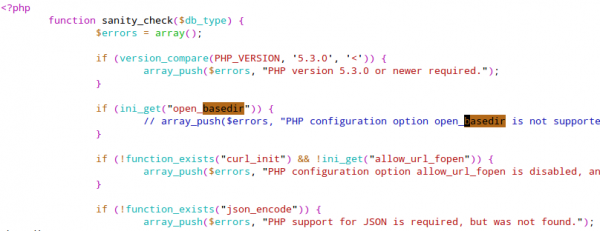
And you need to do the same in the include/sanity_check.php file:

2. passthru disabled
I wanted to call the ./update.php --daemon command from the command line but I got following error message:
PHP Warning: passthru() has been disabled for security reasons in /var/www/xxxx/html/update.php on line 150
This is because a secure configured default php.ini has following set:
disable_functions = exec, passthru, shell_exec, system, proc_open, popen, curl_exec, curl_multi_exec, parse_ini_file, show_source
I remove disabled functions per vhost so I don’t have the least common denominator for security. In this case needed to make sure that the update.php called via the command line uses a custom made php.ini. I therefore created this bash script.
#!/bin/bash
export PHPRC="/var/www/php/xxxx/"
./update.php --daemon
In this directory a special php.ini is located which has passthru enabled.
3. undefined function posix_getpid
I wanted to use the update_daemon2.php script as it is recommended but I got following error message:
[09:48:30] [MASTER] installing shutdown handlers
PHP Fatal error: Call to undefined function posix_getpid() in /var/www/xxxx/html/update_daemon2.php on line 223
PHP Fatal error: Call to undefined function posix_getpid() in /var/www/xxxx/html/update_daemon2.php on line 236
PHP Fatal error: Call to undefined function posix_getpid() in /var/www/xxxx/html/update_daemon2.php on line 99
The solution on Centos/RHEL/SL is easy, just install the posix package for php:
yum install php-posix
I hope this post helps others which move to Tiny Tiny RSS and still want a reasonably secure PHP setup.
ncdu is better than calling “du -hs *” multiple times :-)
May 12, 2013
I was searching again for some directories or files on one of my servers, which were filling the hard disk. Normally I used du -hs * starting via / and going downwards in the directory structure …. but not this time … I went on the search for a command line program which makes that easier … and I found it: Welcome NCurses Disk Usage.
On CentOS/RHEL/SL you need the EPEL repository and than just type yum install ncdu. On Ubuntu just type sudo apt-get install ncdu.
If you use it via SSH it is recommended to use the option -q which does according to the manual:
-q Quiet mode. While calculating disk space, ncdu will update the screen .10 times a second by default, this will be decreased to once every 2 seconds in quiet mode. Use this feature to save bandwidth over remote connections.
And as I normally know on which partition I want to look (df -h tells me which hard disk is getting full 🙂 ), I use following option too:
-x Only count files and directories on the same filesystem as the specified dir.
which leads to this output after starting it:
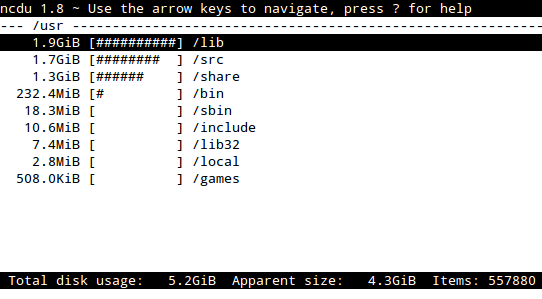
Howto configure a Mikrotik as central DHCP server with switches as DHCP relays
April 27, 2013
I’ve found many articles about how to configure a Mikrotik RouterOS as DHCP relay or as simple DHCP server, but I didn’t find an article about following setup:
- central Mikrotik DHCP Server (e.g. in the data center)
- multiple VLANs/subnets for clients which are connected via a Layer3 Switch (or even more hops) to the central data center
According to the Mikrotik Wiki and the described options it is possible but there is no example shown and everyone uses the setup wizard to configure a DHCP Server. I’ll get most people don’t know what happens in the background … I’ll show this the old fashioned way. 😉
Setup for this example/howto
For this example we assume that we’ve 4 VLANs with following subnets:
- 10.88.0.0/24 (data center VLAN for the servers and the DHCP server)
- 10.88.10.0/24 (clients network location 1)
- 10.88.11.0/24 (clients network location 2)
- 10.88.12.0/24 (clients network location 3)
The Mikrotik has the IP 10.88.0.100 and connected via ether1 to the data center VLAN. The Layer3 switches use always the .1 IP address in the clients networks.
Layer3 Switches / DHCP Relay
Most (if not all) switches which are able to perform at least simple layer 3 tasks (often also labeled as Layer2+ switches) are able to forward DHCP requests. Check the manual of the switch for this. One setting I came across sometimes leads to problems. It is called “DHCP Relay delay” and is sometimes set to 1 or 2 seconds in the the default configuration. This setting allows a local DHCP Server to answer faster, but sometimes (specially embedded clients) don’t wait that long and run into an error. If there is no local DHCP server set this timer to 0 seconds.
You’ll need to set the DHCP Server IP on the switch to the IP of the Mikrotik.
Mikrotik as DHCP Server
First we configure our pools of the client networks, the mikrotik will give out IPs from this ranges:
/ip pool
add name=poolClientsLocation1 ranges=10.88.10.10-10.88.10.250
add name=poolClientsLocation2 ranges=10.88.11.10-10.88.11.250
add name=poolClientsLocation3 ranges=10.88.12.10-10.88.12.250
Now we need to set the configuration the DHCP Server will handout the clients:
/ip dhcp-server network
add address=10.88.10.0/24 dns-server=10.88.0.100 gateway=10.88.10.1
add address=10.88.11.0/24 dns-server=10.88.0.100 gateway=10.88.11.1
add address=10.88.11.0/24 dns-server=10.88.0.100 gateway=10.88.12.1
And at last we configure which DHCP Relay gets which configuration/pool:
/ip dhcp-server
add address-pool=poolClientsLocation1 authoritative=yes disabled=no interface=ether1 lease-time=1w name=dhcpClientsLocation1 relay=10.88.10.1
add address-pool=poolClientsLocation2 authoritative=yes disabled=no interface=ether1 lease-time=1w name=dhcpClientsLocation2 relay=10.88.11.1
add address-pool=poolClientsLocation3 authoritative=yes disabled=no interface=ether1 lease-time=1w name=dhcpClientsLocation3 relay=10.88.12.1
This is all … 😉
How to get IPv6 with a Mikrotik router via an IPv6 tunnel broker
March 2, 2013
You want to try IPv6 but you’re provider doesn’t give you IPv6 addresses? If your router is a Mikrotik this howto will show you how to use an IPv6 tunnel brocker. This setup will also work for guys with a dynamic IP as most home users do.
Signup with an IPv6 tunnel broker
Go to this Wikipedia page for a list of IPv6 tunnel brokers. I’ve chosen the guys at Hurricane Electric as its free and works also with dynamic IP addresses. Other brokers which provide also 6in4 (in RouterOS called /interface 6to4) which provide a method to update of your IP address via a web URL will work too. If you’ve a static IPv4 address the choosing gets even easier.
Following shows whats needs to be done if you use Hurricane Electric as tunnel broker. The tunnel broker wants to be able to ping your router via IPv4 … lets enable that (only if you disabled ping in the first place)
/ip firewall filter add chain=input icmp-options=8:0 protocol=icmp src-address=66.220.2.74
Move this rule to a place before the blocking rule. This rule is made in a way that it opens the least possible hole which is needed for the tunnel broker to work. Now go to the broker website and do following:
- Click on “Create Regular Tunnel”
- Under “IPv4 Endpoint (Your side):” enter your current IPv4 address
- Choose a server location, for better performance choose one thats not that far away from you. 😉
- After Creating the Tunnel you’ll be shown a web page with following important information you’ll need later:
- Tunnel ID
- Server IPv4 Address
- Server IPv6 Address
- Client IPv4 Address
- Client IPv6 Address
- Routed /64
For the commands I’ll use “Tunnel ID” if you should use your Tunnel Id and so on.
Mikrotik Tunnel Setup
First make sure that you’ve the IPv6 package enabled -use following command:
[admin@mikrotik] > /system package print
Flags: X - disabled
# NAME VERSION SCHEDULED
0 X ipv6 6.0rc11
.....
In this example it is not enabled, so we need to enable it and reboot.
[admin@mikrotik] > /system package enable ipv6
[admin@mikrotik] > /system reboot
Now it should look like this:
[admin@mikrotik] > /system package print
Flags: X - disabled
# NAME VERSION SCHEDULED
0 ipv6 6.0rc11
.....
After this is done we can start configuring. First we need to create the tunnel endpoint on our side.
[admin@mikrotik] /ip firewall filter> /interface 6to4 add comment="Hurricane Electric IPv6 Tunnel Broker" disabled=no local-address="Client IPv4 Address" mtu=1280 name=sit1 remote-address="Server IPv4 Address"
After that we need to tell the router this is his new default gateway.
[admin@mikrotik] /ip firewall filter> /ipv6 route add dst-address=2000::/3 gateway="Server IPv6 Address"
And of course we need also an IPv6 address.
[admin@mikrotik] /ip firewall filter> /ipv6 address add address="Client IPv6 Address"/64 advertise=yes eui-64=no interface=sit1
Now we can test our setup the first time. Lets check if the router is able to ping an IPv6 address in the Internet … we use for this the Google DNS servers.
[admin@mikrotik] > ping 2001:4860:4860::8844
HOST SIZE TTL TIME STATUS
2001:4860:4860::8844 56 58 36ms echo reply
2001:4860:4860::8844 56 58 35ms echo reply
2001:4860:4860::8844 56 58 46ms echo reply
sent=3 received=3 packet-loss=0% min-rtt=35ms avg-rtt=39ms max-rtt=46ms
If this does not work .. try to ping “Server IPv6 Address”. If this does work you got something wrong which the default gateway. If this also does not work .. check your tunnel setup and your IPv6 address.
Mikrotik Setup for the Clients
Now we got it working for the Mikrotik but it would be even better to have IPv6 for the clients. To achieve this we need to configure an IPv6 address on the LAN interface and enable
the advertisement to the clients. Take the “Routed /64” address and add an 1 between the :: and the “/” – this give you the first IP address in the routed subnet.
e.g. 2001:xxx:xxx:xxx::/64 –> 2001:xxx:xxx:xxx::1/64
This leads to following command:
/ipv6 address add interface="your LAN interface" address="IP address in your routed IPv6 subnet" advertise=yes
Now wait a little bit (some minutes) and check if your client operation system got an IPv6 address from the routed subnet. I’ll show it here on an Ubuntu 12.04:
$ ifconfig
eth0 Link encap:Ethernet HWaddr 00:xx:xx:xx:xx:xx
inet addr:10.xx.xx.xx Bcast:10.xx.xx.xx Mask:255.255.255.0
inet6 addr: 2001:470:xxx:xxx:xxx:xxx:xxx:xxx/64 Scope:Global
inet6 addr: 2001:470:xxx:xxx:xxx:xxx:xxx:xxx/64 Scope:Global
inet6 addr: fe80::xxx:xxx:xxx:xxx/64 Scope:Link
UP BROADCAST RUNNING MULTICAST MTU:1500 Metric:1
RX packets:5733100 errors:0 dropped:0 overruns:0 frame:0
TX packets:4191113 errors:0 dropped:0 overruns:0 carrier:0
collisions:0 txqueuelen:1000
RX bytes:4271914251 (4.2 GB) TX bytes:841997928 (841.9 MB)
Interrupt:22 Memory:f6ae0000-f6b00000
You’ll see 3 IPv6 addresses, which are used for following:
- Scope: Link: Only used for communication within the local VLAN … is always there if IPv6 is enabled on the client
- Scope:Global: The second one has the MAC address of this interface in it. This is already a worldwide IP address, but it will tell everyone your MAC address .. which is not that good. So there is the first global one which uses a random part. This feature is called “privacy extension” and the IP is changed by the system after some time. If the privacy extension is activated this IP will be used for communicating.
If you’ve 2 or better 3 IPv6 addresses you can try to ping the Google DNS server:
$ ping6 2001:4860:4860::8844
PING 2001:4860:4860::8844(2001:4860:4860::8844) 56 data bytes
64 bytes from 2001:4860:4860::8844: icmp_seq=1 ttl=57 time=36.7 ms
64 bytes from 2001:4860:4860::8844: icmp_seq=2 ttl=57 time=39.6 ms
64 bytes from 2001:4860:4860::8844: icmp_seq=3 ttl=57 time=48.6 ms
64 bytes from 2001:4860:4860::8844: icmp_seq=4 ttl=57 time=55.3 ms
So this seems to work .. now we need to check if your DNS server reports IPv4 and IPv6 addresses back .. if this is not the case your need to configure your DNS correctly or change to an other server … e.g. the Google DNS Servers.
We’ll verify the correct working with following command:
$ host robert.penz.name
robert.penz.name has address 108.162.198.82
robert.penz.name has address 108.162.199.82
robert.penz.name has IPv6 address 2400:cb00:2048:1::6ca2:c652
robert.penz.name has IPv6 address 2400:cb00:2048:1::6ca2:c752
robert.penz.name mail is handled by 10 mail.penz.name.
This looks good … now you’ll only need to configure a firewall on your Mikrotik as you’re clients now have IPv6 address which can be reached worldwide. Your IPv4 firewall is not enough – you need to filter in /ipv6 firewall.
Mikrotik Setup for users with a dynamic IPv4 address
Now we need to make sure the tunnel broker knows our new IPv4 address after each change. For this Hurricane Electric’s provides a web URL which is described here. Thats nice as there are already some DynDNS update scripts available in the Mikrotik Wiki.
I’ve changed the 5.x one in following parts:
- “username”: Your Hurricane Electric’s username
- “password”: Your Hurricane Electric’s password
- “hostname”: Your “Tunnel ID”
- I’ve changed the
/tool fetchline by replacingmembers.dyndns.orgwithipv4.tunnelbroker.net - And at last I added
/interface 6to4 set 0 local-address=$currentIPafter:log info ("UpdateDynDNS: Dyndns Update Result: ".$result)line as we need also to change our local tunnel IP address.
Thats it .. call this script every few minutes and you’ll have IPv6 connectivity even after your IP address changes. I’ll hope this article gets others also in the IPv6 world.
Retrieve remote FTP or SMTP TLS server certificate
February 26, 2013
With SSL protected resources it is easy to find a command line to retrieve the certificate. Following is documented at many places:
openssl s_client -connect www.google.com:443
But if you use use this with a TLS server, be it SMTP or FTP you’ll get
CONNECTED(00000003)
527654:error:140770FC:SSL routines:SSL23_GET_SERVER_HELLO:unknown protocol:s23_clnt.c:607:
The solution ins quite easy (if you know it) .. use following command line:
openssl s_client -connect ftp.xxxx.at:21 -starttls ftp
or
openssl s_client -connect smtp.xxxx.at:25 -starttls smtp
IPv6 OpenVZ VEs and Debian/Proxmox as host system
February 24, 2013
A friend of mine got a new root server and asked me to help him set it up. And of course I helped and as he got a free IPv6 subnet I thought lets configure it. He is running Proxmox as his host system, which is based on Debian.So this guide is also true for Debian systems which have OpenVZ installed.
- You want to use IPv6 for the host system, you need to add at least following to
/etc/network/interfaces
iface vmbr0 inet6 static
address 2001:xxxx:xxxx:xxx::1
netmask 64
up ip -6 route add default via 2001:xxxxx:beef::1 dev vmbr0
down ip -6 route del default via 2001:xxxxx:beef::1 dev vmbr0Replace
vmbr0witheth0if you’re not using Proxmox and only OpenVZ on Debian. - The ISP my friend has the server located at uses a default gateway, which is not in his IPv6 subnet, you need therefore add a host route. Which is done be following 2 lines
up ip -6 route add 2001:4ba0:fff7:1:beef::1 dev vmbr0
down ip -6 route del 2001:4ba0:fff7:1:beef::1 dev vmbr0 - Restart the networking with:
/etc/init.d/networking restart - Test it with following:
ping6 yourOwnIPping6 defaultGWping6 2001:4860:4860::8888(Google IPv6 DNS Server)
- Add following to
/etc/sysctl.confand make sure it is not defined two times
# IPv6 Packet Forwarding and Proxy NDP
net.ipv6.conf.default.forwarding = 1
net.ipv6.conf.all.forwarding = 1
net.ipv6.conf.default.proxy_ndp = 1
net.ipv6.conf.all.proxy_ndp = 1 - Call
sysctl -pto activate it at once (so no reboot is required) - Go to
/etc/vz/vz.confand make sure following is in there
IPV6="yes" - You currently can’t add an IPv6 address through the web GUI of Proxmox – so you need to use the CLI (replace with a IP adresse from your IPv6 range
vzctl set <VEID> --ipadd 2001:xxx:xxx::xxx --save - restart the VE, and try the ping stuff from step 4 in the VE. (ps: It can take up to 5 pings before you get a response the first time.)
More is not needed … its quite easy!
ps: don’t forget to add an IPv6 DNS server, if it is a IPv6 only VE. This can currently not be done via Proxmox web GUI.
pps: iptables does not filter IPv6 .. you need ip6tables for this. don’t think that you’re secure, if you didn’t open anything with iptables.
A howto for using a Canon PIXMA MG4250 under Ubuntu
December 7, 2012
We’ve bought a new multi functions printer at home, a Canon PIXMA MG4250 and as we’re a Linux shop (PCs and notebooks under Linux, mobiles and tablets under Android) I needed to make the printer work under Ubuntu, in our case Ubuntu 12.04, but the solution should work also under newer versions. We’ve connected the printer via WiFi and therefore need both printing and scanning to work via WiFi.
At least at the time of writing this blog post, searching for a driver or howto was not that easy, specially if you search on the US or European Canon Site …. you need to got the Asian site. You wont find the MG4250 listed there but the MG4270. Take it. I should lead you to a driver site where you can choose “Linux” and than 2 links are interesting for you
- MG4200 series ScanGear MP Ver. 2.00 for Linux (debian …
- MG4200 series IJ Printer Driver Ver. 3.80 for Linux (debian …
I provided direct links to the drivers above but the version may change or the URLs themselves – so maybe the links are broken at the time you’re reading it – in this case you need to click through the site to the new pages.
As you see the drivers are generic for the whole MG4200 series so we’re good. Download the tar.gz files and open a console (e.g. CTRL-ALT-T) and change to that directory.
Printing Part
Lets start with the printing part by extracting the tar.gz and changing into the newly created directory.
$ tar xzf cnijfilter-mg4200series-3.80-1-deb.tar.gz
$ cd cnijfilter-mg4200series-3.80-1-deb/
And let the installation process begin with (if prompted for a password use your user password )
$ ./install.sh
After installing the packages you will be asked some questions. The first one is to connect your printer and switch it on. This is followed by the connection method you’re using (USB vs network). In the case of network it will broadcast within the same subnet, so it only works if the PC and the printer are on the same subnet. After it detected the printer you need knowledge that and choose if it should be the default printer.
After all this just go to the most top right icon and click onto it to the following menu, choose printers …
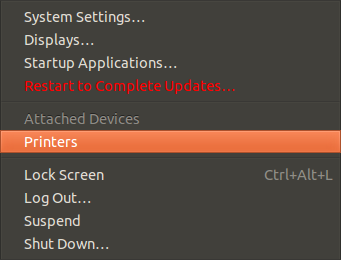
…. and it should show you following with your printer:
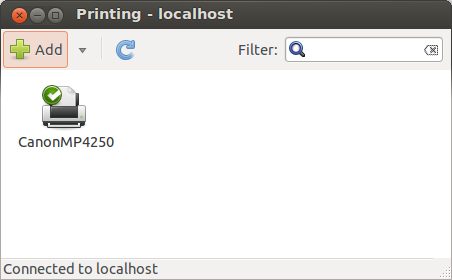
Ok, printing is working … lets go to scanning
Scanning Part
As with the printing part extract the tar.gz and change into the newly created directory.
$ tar xzf scangearmp-mg4200series-2.00-1-deb.tar.gz
$ cd scangearmp-mg4200series-2.00-1-deb/
And again we’re using the install script (if prompted for a password use your user password ).
$ ./install.sh
You’ll be asked no questions and after the installation just start the scanning program with following command
$ scangearmp
It will show you an error message that no configured scanner has been detected, click Ok. Now following window is shown:
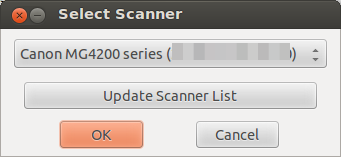
In the case of the first start the list is empty, you need to click onto “Update Scanner List”, after this you should see the same window with your printer. Click onto Ok and you get following:
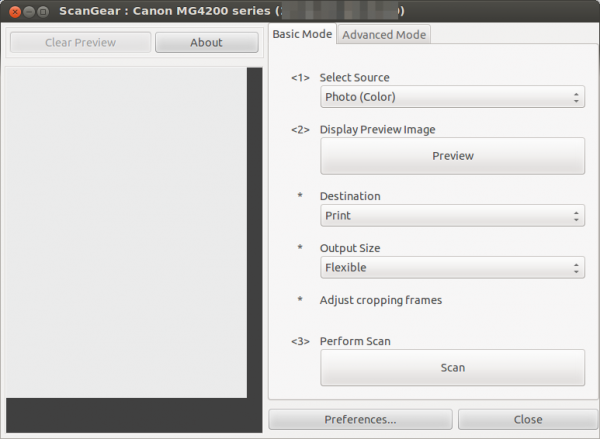
And we’re done.
Update for Ubuntu 13.10 (and possible other versions) users:
If you get following error message:
Unpacking cnijfilter-mg4200series (from .../cnijfilter-mg4200series_3.80-1_amd64.deb) ...
dpkg: dependency problems prevent configuration of cnijfilter-mg4200series:
cnijfilter-mg4200series depends on libtiff4; however:
Package libtiff4 is not installed.
dpkg: error processing cnijfilter-mg4200series (--install):
dependency problems - leaving unconfigured
Errors were encountered while processing:
cnijfilter-mg4200series
Just install the library with
$ sudo apt-get install libtiff4
and the call the install.sh again and it will work.
Howto flush the DNS cache in Ubuntu 12.04?
November 18, 2012
I guess most of you know how to flush the DNS cache on Windows
ipconfig /flushdns
but how to you do it with Ubuntu? Just open with CTR-ALT-T the terminal and type following
sudo /etc/init.d/dns-clean
Powered by WordPress
Entries and comments feeds.
Valid XHTML and CSS.
38 queries. 0.065 seconds.





